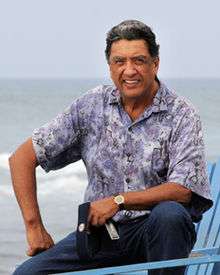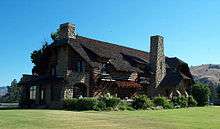Mel Pervais
| Mel Pervais | |
|---|---|
 | |
| Born | Thunder Bay, Ontario |
| Nationality | American |
| Occupation | Engineer, entrepreneur |
| Known for | Cataract Inc., Rhodium 2001 |
Melvin "Mel" Pervais is a Canadian-American business executive, entrepreneur, engineer and member of the Ojibwa Nation.
Early life and education
Pervais was born and raised on the Fort William Reserve near Thunder Bay, Ontario, the eldest son of eight children. At age five he began his academic studies in a one-room schoolhouse, housing eight grades, on the reserve. At age twelve he was sent to a Jesuit-run boarding school for Indian boys, the Garnier Residential School, 500 miles (800 km) away in Spanish, Ontario, and graduated at sixteen.[1]
Career
Early career
At age sixteen, Pervais started work as a night watchman for the Jones Construction Company.[2] Two months later, he took the opportunity to begin an apprenticeship as an instrument technician with Noranda Mines in Cutler, Ontario. Over the next seventeen years, he held various positions in the power generation industry before joining Johnson Controls in 1973 as the manager of a newly formed calibration engineering department. Pervais redirected the department's focus to nuclear power, boosting sales from $100,000 to $5 million over three years.
Cataract Inc.
Pervais left Johnson Controls in 1976 and, with his expertise and $10,000, started Amalgamated Services in Philadelphia with a business partner, providing engineering services to nuclear power plants.[3] In 1979 the company merged with Cataract Engineering and Construction and Pervais became president.[3] Never shy about his Indian heritage, Cataract's logo had an Indian motif and the company strived to hire Indian employees.[3] Cataract also used a unique bonus and salary system to discourage sick days and draw talent from other companies; it was not uncommon for workers to out-earn their bosses, with some field technicians earning $90,000 a year.[4]
Pervais sold Cataract Inc. through an employee stock ownership program for $20 million.[5] At the time, Cataract had 500 engineers and technicians and reported annual sales of $50 million.[1] He retired at age 45 to focus on a horse breeding and cattle operation on the Chief Joseph Ranch near Darby, Montana.[1] The Los Angeles Times reported in 1984 that Pervais was one of the wealthiest Native Americans in the United States.[3]
Rhodium 2001
In 1991, Pervais returned from retirement to found Rhodium 2001, dedicated to recycling materials from scrapped catalytic converters. Pervais put more than $2 million of his own money into the new company, originally housed in a remodeled calving barn on his ranch.[6] Pervais and partner Don Golbeck bought a license to a process developed by metallurgist inventor and chemical engineer C.A. Dickey to refine precious group metals from automotive catalytic converters, a process they used to retrieve a number of materials, including fine sand for the asphalt industry and platinum, palladium and rhodium compounds to sell to refiners.[7]
Rhodium 2001's extraction process is notable for being environmentally friendly, requiring no smelter nor airborne emissions, and for being a closely guarded secret. It took two years of research and development by Dickey, who claimed it involved temperature and pressure. Neither Pervais, nor Dickey, were willing to reveal more about the process than that, for fear that other competitors might adopt it, rendering their company irrelevant. Said Pervais, "If you're an environmentalist, it's probably the greatest invention. I don't need a polluting process. I'd stay retired if that was the case."[6]
Service and distinctions
Pervais, whose grandfather was a tribal chief,[3] has said his father pushed him into the non-Native American world at an early age. "It was the most traumatic thing he ever did," he says. "But it was the best thing he ever did for me."[8] Pervais is an advocate for self-sufficiency in the Native American community and has spoken before students and other groups arguing that Native Americans must stop relying on federal aid and begin supporting themselves in the free-enterprise system.[9]
In 1982 Pervais was invited by President Ronald Reagan to serve on a private sector task force that encouraged support of community projects including homes for the elderly and day care centers.[4]
Pervais received honorary Doctorates of Engineering from Montana State University in 1995 and Lakehead University in 1996.[1] Pervais is a former member of the United Indian Development Association, a Los Angeles organization that provides consulting services to Indian businesses.[4] He is on the council of trustees with United National Indian Tribal Youth Inc. (UNITY),[10] a national organization promoting personal development, citizenship and leadership among Native American youth.
Chief Joseph Ranch

In 1987, Pervais bought the 1,400-acre (5.7 km2) Chief Joseph Ranch, including a 5,000-square-foot (460 m2) lodge built in 1917, a summer home for the family of William Ford. After the Fords sold it in 1952, it traded hands several times. When Pervais took it over, the ranch was in poor shape; the barns were falling apart and its perimeter was unfenced. Pervais improved the property and extensively renovated the lodge to its Ford-era conditions over a ten-year period. At the time, he owned a pet bobcat, Toma, named for one of Chief Joseph's wives.[11] Pervais sold the ranch in 2004. Today it is a bed and breakfast.[12]
Personal
Pervais married Lynda Hart Bailey, former wife of lawyer F. Lee Bailey, in 1985. Peter MacDonald, a former Navajo Tribal Chairman, served as Bailey's adopted Navajo "father" and offered twelve wild horses, a traditional dowry to the groom and a Navajo medicine man. In accordance with Pervais' Ojibwa heritage, a second ceremony took place at sundown the day after the wedding on the night of a new moon. Pervais is the father of seven children.[8]
References
- 1 2 3 4 "Aboriginal Profile: Pervais, Melvin". Lakehead University Program for the May, 1996 Convocation. Retrieved 13 Nov 2009.
- ↑ Catherine Elston (April 18, 1984). "Tycoon is man of two worlds". Hopi-Navajo Observer.
- 1 2 3 4 5 The Los Angeles Times. Los Angeles. January 12, 1984. p. 3. Missing or empty
|title=(help); - 1 2 3 Business West. November–December 1984. pp. 41, 42. Missing or empty
|title=(help); - ↑ Securities Week. November 20, 1995. p. 1. Missing or empty
|title=(help); - 1 2 Carlotta Grandstaff (April 6, 1985). Ravalli Republic. Ravalli, Montana. Missing or empty
|title=(help); - ↑ Missoulian. Missoula. February 23, 1992. p. 1. Missing or empty
|title=(help); - 1 2 Greenya, John (15 July 1985). "An Indian Love Story Becomes An Unforgettable High Plains Wedding". People Magazine. Retrieved 16 Nov 2009.
- ↑ Scottsdale Daily Progress. Scottsdale. March 4, 1992. p. 1. Missing or empty
|title=(help); - ↑ "Unity Council of Trustees". unityinc.org. United National Indian Tribal Youth Inc. 2007. Retrieved 24 June 2010.
- ↑ Barbara Lloyd (April 8, 1993). "Log Mansion that Recalls Indian History". The New York Times. New York City. pp. 1, section C. Retrieved 13 Nov 2009.
- ↑ "Our Story". chiefjosephranch.com. Chief Joseph Ranch. 2004. Retrieved 24 June 2010.
External links
- Mel Pervais profile
- Rhodium 2001 company profile